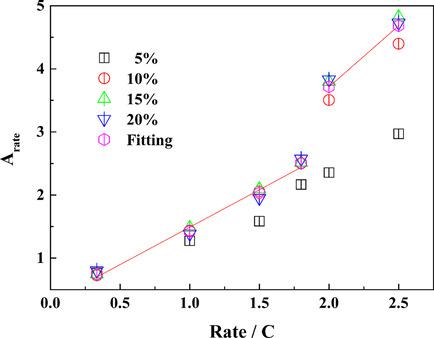当前位置:
X-MOL 学术
›
ChemElectroChem
›
论文详情
Our official English website, www.x-mol.net, welcomes your feedback! (Note: you will need to create a separate account there.)
Accelerated Aging Analysis on Cycle Life of LiFePO4/Graphite Batteries Based on Different Rates
ChemElectroChem ( IF 4 ) Pub Date : 2018-06-12 , DOI: 10.1002/celc.201800326 Shun Sun 1 , Ting Guan 1 , Pengjian Zuo 1 , Yunzhi Gao 1 , Xinqun Cheng 1 , Chunyu Du 1 , Geping Yin 1, 2
ChemElectroChem ( IF 4 ) Pub Date : 2018-06-12 , DOI: 10.1002/celc.201800326 Shun Sun 1 , Ting Guan 1 , Pengjian Zuo 1 , Yunzhi Gao 1 , Xinqun Cheng 1 , Chunyu Du 1 , Geping Yin 1, 2
Affiliation

|
In this study, different charge/discharge rates (1/3C, 1C, 1.5C, 1.8C, 2.0C and 2.5C) are used to accelerate the aging of commercial LiFePO4/graphite cells. The capacity attenuation mechanism is investigated by disassembling the aged full cells and analyzing the morphologies and chemical composition of electrode surfaces, the single electrode potentials, and so forth, when the capacity retention of full cell decays to 95 %, 90 %, 85 %, and 80 %. Through the tests, the capacity fade of the full cell is mainly ascribed to the irreversible loss of active lithium. However, when the test rate is not lower than 2.0C, the dominant mechanism for consumption of active lithium is changed to lithium deposition on the anode during the charging process instead of the generation of SEI film. As a consequence, the capacity decay rate at 2.0C or 2.5C is accelerated to a large degree. The capacity loss with cycling time is fitted by Arrhenius equations. The pre‐exponential factor at a given rate (Arate) increases linearly with the rising test rate when it is not more than 1.8C, and this corresponds to the results of disassembly analysis. Therefore, an unknown Arate in a reasonable range can be extrapolated by the data of other Arate values at relatively high rates. In addition, the calculated Arate after 10 % capacity loss can be used to replace the fitted value by the whole aging data. This provides a rapid and practical approach to estimate the lifetime of the full cell.
中文翻译:

基于不同速率的LiFePO4 /石墨电池循环寿命加速老化分析
在这项研究中,使用不同的充电/放电速率(1 / 3C,1C,1.5C,1.8C,2.0C和2.5C)来加速商用LiFePO 4的老化。/石墨细胞。通过分解老化的满电池并分析电极表面的形貌和化学组成,单电极电势等来研究容量衰减机理,当满电池的容量保留率分别下降至95%,90%,85%,和80%。通过测试,整个电池的容量衰减主要归因于活性锂的不可逆损失。然而,当测试速率不低于2.0C时,消耗活性锂的主要机理改变为在充电过程中锂沉积在阳极上而不是产生SEI膜。结果,在2.0C或2.5C下的容量衰减率被大大加速。容量随循环时间的损失由Arrhenius方程拟合。给定速率下的指数前因子(甲速率)与上升测试速率线性增加,当它不超过1.8C,并且这对应于拆卸分析的结果。因此,可以通过较高速率下的其他A速率值的数据推断出合理范围内的未知A速率。另外,容量损失10%后的计算出的A率可用于替换整个老化数据的拟合值。这提供了一种快速而实用的方法来估算整个电池的寿命。
更新日期:2018-06-12
中文翻译:

基于不同速率的LiFePO4 /石墨电池循环寿命加速老化分析
在这项研究中,使用不同的充电/放电速率(1 / 3C,1C,1.5C,1.8C,2.0C和2.5C)来加速商用LiFePO 4的老化。/石墨细胞。通过分解老化的满电池并分析电极表面的形貌和化学组成,单电极电势等来研究容量衰减机理,当满电池的容量保留率分别下降至95%,90%,85%,和80%。通过测试,整个电池的容量衰减主要归因于活性锂的不可逆损失。然而,当测试速率不低于2.0C时,消耗活性锂的主要机理改变为在充电过程中锂沉积在阳极上而不是产生SEI膜。结果,在2.0C或2.5C下的容量衰减率被大大加速。容量随循环时间的损失由Arrhenius方程拟合。给定速率下的指数前因子(甲速率)与上升测试速率线性增加,当它不超过1.8C,并且这对应于拆卸分析的结果。因此,可以通过较高速率下的其他A速率值的数据推断出合理范围内的未知A速率。另外,容量损失10%后的计算出的A率可用于替换整个老化数据的拟合值。这提供了一种快速而实用的方法来估算整个电池的寿命。



























 京公网安备 11010802027423号
京公网安备 11010802027423号